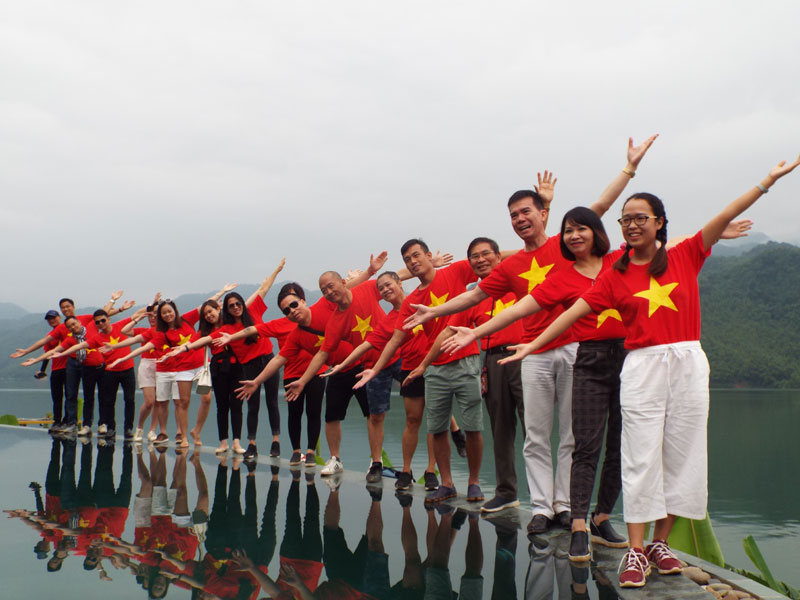
(HBO) - In recent years, Hoa Binh tourism has made great progress. Hoa Binh is an intersection, being adjacent to Hanoi Capital and the Northern Delta region. It is rich in cultural identity, charming natural scenery and fresh climate. There are precious resources helping develop various types of tourism. The "Hoa Binh Culture" dates back to prehistoric times, which is famous for 4 Muong: Bi, Vang, Thang and Dong.

Mai Chau Hideaway in Suoi Lo hamlet, Tan Mai commune, Mai
Chau district
The ethnic
people of Thai, Mong and Dao have their own cultural characteristics, creating a
diverse and rich cultural nuance with many unique folk festivals, deeply imbued
with national cultural identities. The province has natural reserves such as Ngoc
Son - Ngo Luong in Tan Lac and Lac Son districts, Thuong Tien (Kim Boi), Hang
Kia - Pa Co (Mai Chau) and Phu Canh (Da Bac) with the dynamic animal and plant
systems. They are great potential for ecotourism development. There are 296
historical and cultural relics, scenic spots that are managed and protected in
the province. Many tangible and intangible cultural values are being restored
and developed. In particular, in Hoa Binh there is Song Da lake, the largest
artificial lake in Southeast Asia approved by the Prime Minister of the
National Tourism Development Master Plan. Mai Chau district is defined as a
national tourist site. There are a lot of famous tourist spots in the province
that have created the tourist attraction for Hoa Binh tourism. In recent years,
the provincial tourism has achieved important results. The number of tourists
and the total revenue from tourism activities has increased by an average of
20% per year, which is a certain contribution in the socio-economic development
of the province. Particularly, the improvement of the business environment,
removing difficulties for investors, strengthening the information, promotion
and implementation of the policies have encouraged the investment, attracting
potential businesses to take part in the construction of the quality tourism
products. Especially Hoa Binh lake national tourist area, the national tourist
destination of Mai Chau district and a number of other key localities have been
approved
The service
quality of the tourist destinations in the area has been significantly
improved. In 2018, Hoa Binh welcomed 2.7 million turns of visitors. In
particular, the international visitors were 312,193 turns of people. The total income
from tourism was about 1,520 billion VND and the total revenue reached 844,898
billion VND.
Located just a 20-minute drive from Hoa Binh City, Ora Hill Farmstay & Glamping Hoa Binh is a captivating new destination nestled in Mo hamlet, Bình Thanh commune, Cao Phong district. Combining farming with leisure, this tranquil retreat is perfect for those seeking balance, joy, and an immersive experience in the expansive beauty of nature.
Muong Bi - Tan Lac is renowned as one of the four famous Muong regions in Hoa Binh province. Blessed by nature with a favourable climate and stunning landscapes, Tan Lac holds great advantages for tourism development. The local tourism industry has made remarkable strides in recent times thanks to the attention and support from the local authorities and sectors.
With its strategic location, well-developed transport network, and diverse soil and climatic conditions, Hoa Binh is emerging as a must-visit destination in Vietnam's northwestern tourism corridor. The province boasts numerous attractions, including the Kim Boi hot springs (Kim Boi district), the Dau Rong cave complex (Cao Phong), the Mai Chau valley (Mai Chau), and the iconic Hoa Binh hydropower plant.
The northern mountainous province of Hoa Binh has been listed among the 71 most beautiful places to visit worldwide by the prestigious US travel magazine Condé Nast Traveller.
Hoa Binh province’s rich natural and cultural resources position it as a prime location for developing community-based tourism (CBT). In recent years, support from central and provincial policies, as well as assistance from non-governmental organisations, have encouraged local ethnic minority and mountainous communities to actively engage in the sector.



